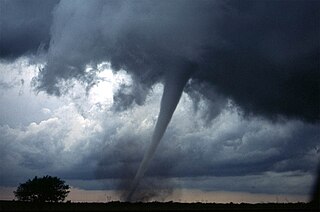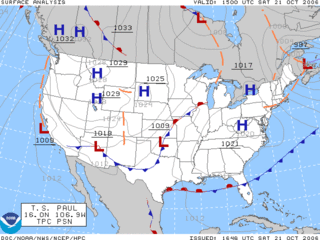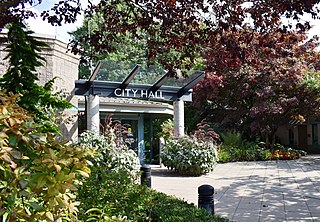Related Research Articles

Snow comprises individual ice crystals that grow while suspended in the atmosphere—usually within clouds—and then fall, accumulating on the ground where they undergo further changes. It consists of frozen crystalline water throughout its life cycle, starting when, under suitable conditions, the ice crystals form in the atmosphere, increase to millimeter size, precipitate and accumulate on surfaces, then metamorphose in place, and ultimately melt, slide or sublimate away.

Convection is single or multiphase fluid flow that occurs spontaneously due to the combined effects of material property heterogeneity and body forces on a fluid, most commonly density and gravity. When the cause of the convection is unspecified, convection due to the effects of thermal expansion and buoyancy can be assumed. Convection may also take place in soft solids or mixtures where particles can flow.

Extreme weather includes unexpected, unusual, severe, or unseasonal weather; weather at the extremes of the historical distribution—the range that has been seen in the past. Extreme events are based on a location's recorded weather history. They are defined as lying in the most unusual ten percent. The main types of extreme weather include heat waves, cold waves and heavy precipitation or storm events, such as tropical cyclones. The effects of extreme weather events are economic costs, loss of human lives, droughts, floods, landslides. Severe weather is a particular type of extreme weather which poses risks to life and property.

A thunderstorm, also known as an electrical storm or a lightning storm, is a storm characterized by the presence of lightning and its acoustic effect on the Earth's atmosphere, known as thunder. Relatively weak thunderstorms are sometimes called thundershowers. Thunderstorms occur in a type of cloud known as a cumulonimbus. They are usually accompanied by strong winds and often produce heavy rain and sometimes snow, sleet, or hail, but some thunderstorms produce little precipitation or no precipitation at all. Thunderstorms may line up in a series or become a rainband, known as a squall line. Strong or severe thunderstorms include some of the most dangerous weather phenomena, including large hail, strong winds, and tornadoes. Some of the most persistent severe thunderstorms, known as supercells, rotate as do cyclones. While most thunderstorms move with the mean wind flow through the layer of the troposphere that they occupy, vertical wind shear sometimes causes a deviation in their course at a right angle to the wind shear direction.

Surface weather analysis is a special type of weather map that provides a view of weather elements over a geographical area at a specified time based on information from ground-based weather stations.

La Niña is an oceanic and atmospheric phenomenon that is the colder counterpart of El Niño, as part of the broader El Niño–Southern Oscillation (ENSO) climate pattern. The name La Niña originates from Spanish for "the girl", by analogy to El Niño, meaning "the boy". In the past, it was also called an anti-El Niño and El Viejo, meaning "the old man."

Norman is the third-most populous city in the U.S. state of Oklahoma, with a population of 128,026 as of the 2020 census. It is the most populous city and the county seat of Cleveland County and the second-most populous city in the Oklahoma City metropolitan area after the state capital, Oklahoma City, 20 miles north of Norman.

A squall is a sudden, sharp increase in wind speed lasting minutes, as opposed to a wind gust, which lasts for only seconds. They are usually associated with active weather, such as rain showers, thunderstorms, or heavy snow. Squalls refer to the increase of the sustained winds over that time interval, as there may be higher gusts during a squall event. They usually occur in a region of strong sinking air or cooling in the mid-atmosphere. These force strong localized upward motions at the leading edge of the region of cooling, which then enhances local downward motions just in its wake.

Coquitlam is a city in the Lower Mainland of British Columbia, Canada. Mainly suburban, Coquitlam is the sixth-largest city in the province, with a population of 148,625 in 2021, and one of the 21 municipalities comprising Metro Vancouver. The mayor is Richard Stewart.

Pitt Meadows is a municipality of Metro Vancouver in southwestern British Columbia, Canada. Incorporated in 1914, it has a land area of 86.34 square kilometres (33.34 sq mi) and a population of 19,146 as of 2021. The municipality received its name from the Pitt River and Pitt Lake. Pitt Meadows is one of 21 municipalities plus Electoral Area A that comprises the Metro Vancouver Regional District.
Popular music in British Columbia is strongly associated with the city of Vancouver. As Canada's third largest city, Vancouver has one of the most influential rock and pop scenes in the country. It is also, like Toronto, a common destination for musicians from other parts of the country and from the United States. Additionally, Vancouver has been especially prominent in genres, such as punk rock and hip hop, which tend to be associated with larger cities. Many significant artists have hailed from cities and towns across British Columbia.

Rock Island State Park is a state park of Wisconsin located on Rock Island off the tip of the Door Peninsula at the eastern edge of Green Bay and Lake Michigan.

Archbishop Carney Regional Secondary School is a private independent secondary school in Port Coquitlam, British Columbia.
Coquitlam Dam is a hydraulic fill embankment dam on the Coquitlam River in the city of Coquitlam, British Columbia. Although it has no powerhouse of its own, its waters divert to Buntzen Lake, making it part of BC Hydro's electrical generation infrastructure. It is also one of the main reservoirs for the Greater Vancouver Water District. BC Hydro has released a new document in March 2018 that addresses emergency preparedness and outlines the areas effected should the dam fail as a result of an extreme earthquake event.

Numb is a 2007 American dark romantic comedy film written and directed by Harris Goldberg. According to an interview with Goldberg on a bonus feature of the DVD release, he was inspired to write the screenplay by his own experience battling depersonalization disorder and clinical depression.

Lafarge Lake is a five-hectare man-made lake, located in Town Centre Park in central Coquitlam, British Columbia. The Evergreen Cultural Centre lies on the southwest corner of the lake, and the Water's Edge Festival is held on the lake shore for 25 continuous hours in March.

A cold front is the leading edge of a cooler mass of air at ground level that replaces a warmer mass of air and lies within a pronounced surface trough of low pressure. It often forms behind an extratropical cyclone, at the leading edge of its cold air advection pattern—known as the cyclone's dry "conveyor belt" flow. Temperature differences across the boundary can exceed 30 °C (54 °F) from one side to the other. When enough moisture is present, rain can occur along the boundary. If there is significant instability along the boundary, a narrow line of thunderstorms can form along the frontal zone. If instability is weak, a broad shield of rain can move in behind the front, and evaporative cooling of the rain can increase the temperature difference across the front. Cold fronts are stronger in the fall and spring transition seasons and are weakest during the summer.
Festival du Bois is an annual Francophone festival held in the Maillardville neighbourhood of Coquitlam, British Columbia, Canada. This year, Festival du Bois will be held from March 24 to 26. Produced by Societe francophone de Maillardville, the festival celebrates French Canadian history, art and culture.
Havana Jam was a three-day music festival that took place at the Karl Marx Theatre, in Havana, Cuba, from March 2 to March 4, 1979. It was sponsored by Bruce Lundvall, the president of Columbia Records, Jerry Masucci, the president of Fania Records, and the Cuban Ministry of Culture.
Water's Edge may refer to:
References
- ↑ Water's Edge: Introduction Retrieved on 10 May 2009
- ↑ Tri-City News: Cold weather for first Water's Edge 9 March 2009